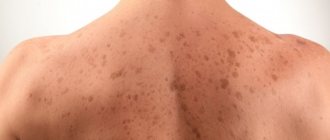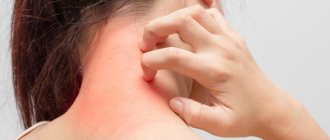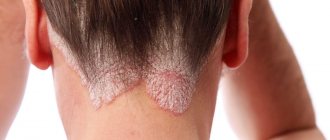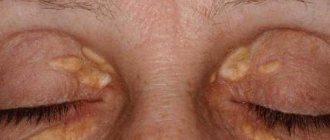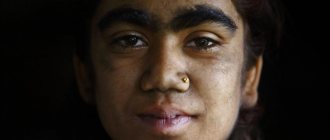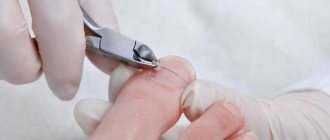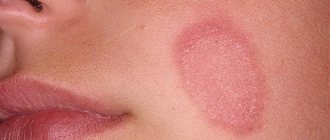Lentigo - what is it?
Here we are not talking about freckles, which appear in some people with increasing solar activity.
Lentigo is a slight pigmentation of the skin that does not disappear all year round. Sometimes it appears spontaneously.
This phenomenon is classified as a disease, which is a type of benign skin lesion. Develops against the background of excess melanin in the dermis.
Solar lentigines or lentigines are very common in people over 40 years of age. Sometimes they are also called “age spots” or “senile freckles”.
Dermatologist Fatima Ahmed
The key symptom of lentigo is the sudden appearance of small brown spots on the skin, with a diameter of 1.5 to 3 cm. Moreover, they can be localized on the face, neck, back, arms and other parts of the body (see photo) in both women and men . It is also possible to damage the mucous membranes.
Lentigo is conventionally divided into congenital and acquired. If there are too many spots, then the diagnosis is lentiginosis.
The danger of this dysfunction is that it can develop from benign pigmentation to malignant. According to statistics, this happens in 4%.
The risk of such degeneration increases due to a number of facts:
- Getting more than three sunburns in your lifetime.
- Combination of lentigo with freckles.
- The presence on the epidermis of more than three spots of atypical size and shape.
The exact causes of lentigo are not known, except for a form that is inherited. However, certain provoking factors have been identified:
- excessive sensitivity of the epidermis to ultraviolet radiation;
- fanatical addiction to sunbathing and repeated sunburn (especially in childhood);
- fair skin and red hair;
- advanced age;
- frequent visits to the solarium;
- suppressed immunity due to the use of depressants, cyostatics and glucocorticoids, as well as due to poor nutrition;
- papilloma virus infection;
- endocrine changes during pregnancy, during puberty and the onset of menopause;
- disruptions in the gastrointestinal tract;
- injuries of various origins;
- severe poisoning;
- inflammatory processes of a dermatological nature.
To accurately diagnose the disease itself and find out the cause of its development, you should go to the clinic for a medical examination.
Prevention
The following recommendations will help protect yourself from the recurrence of lentigo:
- Sunbathing time should be strictly limited.
- Avoid visiting the solarium.
- When exposed to the sun, the skin must be treated with cosmetics every time.
- Get rid of such a habit as smoking.
- The diet is balanced and healthy, with a minimum amount of fatty foods.
- If gastric or intestinal diseases are detected, treat promptly.
Solar lentigo manifests itself at a young and mature age. To protect yourself, you need to take care of your skin and avoid prolonged exposure to the scorching sun. If a person finds areas with pigmentation, this phenomenon should not be ignored. You need to make an appointment with a specialist and undergo an examination so that appropriate therapy can be selected.
What are the types of lentigo (5 options)
There is the following classification of lentigo:
- Solar – occurs as a result of prolonged exposure to the sun. People with fair and sensitive skin types are more susceptible to it. The appearance of this type of pigmentation is perceived as a primary sign of photoaging. The spots appear mainly on the neck, arms and face. This type of lentigo is not considered a disease, but rather a cosmetic defect.
- Simple (adolescent or juvenile) - it has nothing to do with ultraviolet radiation and skin aging. Most often it makes itself felt in adolescence or immediately after childbirth in women. Lentigines appear on the skin and mucous membranes in the form of spots up to 10 mm in size.
- Senile - they are also called liver spots. They are dark brown washouts (up to 1 cm in diameter) with uneven contours that appear on the face, neck and arms. People over 50 years of age are more susceptible to this disease if they previously did not particularly adhere to sun protection.
- Melanotic - these are ink-colored spots that appear randomly on the skin, which is more exposed to direct sunlight. They have a teardrop shape.
- PUVA - appears six months after undergoing therapy against psoriasis. The spots have unclear boundaries and resemble freckles in appearance. The torso is more susceptible to damage.
Chloasma also occurs. Women often encounter it during pregnancy or menopause.
Dermatologist Michelle Green
Lentignosis of the mucous components is characterized by a scattering of flat pigment spots of a light cream color and with smooth contours.
Such a disease can be acquired at the genetic level by inheritance or due to certain third-party factors.
Even knowing the signs of each type of lentigo, you should not make a diagnosis yourself. This is only within the competence of the relevant specialist. Therefore, there is no need to postpone your visit to him.
Classification and clinical signs
Congenital lentigo is often multiple, which is why it is called lentigiosis. The spots in this condition are located on the body, with the exception of the facial skin. It is inherited in an autosomal dominant manner. The likelihood that a person with a congenital condition will have a child with the same condition is very high. Touraine's central lentiginosis is most often transmitted: numerous freckles on the face are combined with epilepsy, urinary incontinence, and developmental delays in the child.
In some cases, congenital lentigo is combined with developmental defects: congenital deafness, anomalies of the heart and spine. Congenital spots are often large in size. Sometimes they become malignant.
There are two forms of the disease acquired with age: juvenile and senile lentigo.
Juvenile lentigo
The juvenile form can occur on any part of the body, but most often it is located on the lips and head of the penis in young men. This formation never malignizes, that is, it does not degenerate into skin cancer. It can be single or multiple and ranges in color from brown to dark brown. The occurrence of juvenile lentigo is not associated with exposure to the sun; the reasons for its appearance are unknown.
On microscopic analysis of the formation, it resembles a borderline noncellular nevus. However, its basis is melanocytes, pigment cells of the skin, and not nevocytes, as with nevus. Melanocytes are located in small groups or singly, which distinguishes them from nevocytes, which form clusters - nests.
We would like to separately mention Peutz-Jeghertz syndrome (periorificial lentiginosis). It includes lentigo of the lips, oral mucosa, fingers and/or toes, and cancer of the stomach or colon. The rash appears after the baby is born. Between the ages of 10 and 30 years, polyposis of the stomach and intestines develops with the development of malignant tumors of these organs.
Senile lentigo
It occurs more often in fair-skinned people living in the southern regions. It is associated with prolonged exposure to sunlight. This formation also occurs in some liver diseases. Another name for this condition is solar lentigo.
These formations are larger and generally lighter in color than juvenile ones. The spots reach a diameter of 3 cm and have a light brown tint. On the body they appear where the influence of the sun is strongest - on the back of the hands and face. The spots can merge, reaching large sizes. This form can turn into malignant, and it, in turn, into skin cancer.
Microscopy can detect melanocyte hyperplasia, that is, their increase in size, especially in the lowest layer of the epidermis - the basal layer. Right here. At the border of the epidermis and dermis, club-shaped acanthotic wedges are visible.
Lentigo must be distinguished from the following conditions:
- senile keratoma;
- solar keratosis;
- malignant lentigo.
Senile keratoma is a plaque resembling a wart that rises above the skin. Solar keratoses are red spots that appear on sun-exposed areas of the skin. Both of these conditions can develop into cancer.
Solar lentigo
What is the clinical picture
When pigmentation is detected on the skin, most people do not associate it with any disease. Moreover, rarely does anyone know about lentigo and what it is.
This is due to the fact that the spots do not cause discomfort. The only thing the patient notes is a change in their color from light to darker (as in the photo).
Sometimes the pigmented areas may thicken slightly or become bulging.
Such changes signal the degeneration of this neoplasm from benign to malignant. Then you need to urgently consult a doctor for diagnosis.
If your dermatologist has looked at the spots and determined that they are benign (not cancerous) and cannot turn into skin cancer, then he can begin to treat them. Sometimes we simply freeze the lesions with liquid nitrogen on the day of presentation. Laser treatment can make dark skin even darker if the wrong type of laser was used.
Dermatological surgeon Amy Paul
Diagnostics
Only a specialist can diagnose lentigo and identify its type.
In this case, a comprehensive examination of the upper layer of the epidermis is prescribed, as well as a general examination of the patient. A blood test is required to determine the absence or presence of altered cellular malignant material.
If a specialist has doubts about any pigment spot, then he can take a fragment of the skin, which is then examined in the laboratory. And depending on the result of the biopsy, the doctor prescribes appropriate therapy.
How is lentigo diagnosed (4 procedures)
Establishing a diagnosis does not require any complex laboratory procedures. An examination of the patient by a dermatologist and an anamnesis is sufficient.
What is done during diagnosis:
- Dermatoscopy – a photo of the affected areas is taken in high resolution and in good lighting.
- Biopsy - a piece of tissue is taken from the spot for laboratory testing. This procedure is prescribed if there is doubt about the benignity of the tumors.
- A general blood test and protein tumor markers are necessary to exclude the possibility that hyperpigmentation is malignant.
- Confocal laser scanning microscopy (CLSM ) - this means an instrumental examination of a skin section in layers.
There are no contraindications to performing all these procedures. They are completely safe.
Every time you have a suspicious spot or mole, you should go to a dermatologist for diagnosis.
Dermatological surgeon Mitchell Schwartz
Is it possible to cure this disease and how?
It is necessary to treat lentigo when the spot is too large, is constantly exposed to mechanical and solar influence and spoils the appearance with its presence.
Typically treatment comes down to the following steps:
- regular whitening of pigmented areas on the skin with special medications;
- constant application of protective creams against UV radiation to the skin;
- superficial exfoliation of the epidermis using various cosmetic procedures.
Don't worry if the spots disappear and then return after a few days or weeks. The pigment usually consists of several layers, so peeling occurs layer by layer.
Anesthesiologist Laura Rome
As a last resort, they resort to surgical intervention. Then the lentigo is cut out from the skin surface.
During the operation, the specialist captures part of the healthy tissue so that the stain does not appear again in the future. The remaining scar is easily removed plastically.
Arbutin, azelic acid and licorice extract have a good effect as whitening agents.
They contain ascorbic and kojic acid, retinoids and hydroquinone. The latter component is present in modern drugs, but in minute quantities. All other components are absolutely harmless and easily tolerated.
Laser destruction
For those who want to get rid of lentigo without subsequent scars, laser therapy is recommended.
With it, the beam captures and destroys only the neoplasm, and does not affect healthy tissue in the neighborhood. This procedure is painless and is performed without local anesthesia.
If you have persistent solar lentigo/sun spots, the best combination is the Fraxel Dual laser and Yag laser.
Dermatologist Michelle Green
During the session, the patient may feel a slight tingling sensation on the skin.
Immediately after pigmentation has been reduced, redness may appear in the areas treated with the laser. If you are prone to allergies, slight darkening may appear in these places.
Before laser therapy, the patient must undergo a series of examinations to exclude existing contraindications.
Phototherapy
If the diagnosis of malignant pigmentation is excluded in the patient, then a phototherapy method may be offered.
This means exposing problem areas to a light beam. This stimulates the natural synthesis of collagen, thereby increasing the regenerative capabilities of tissues and rejuvenating them at the cellular level.
I have better results with the Q-swithced laser. I have used the Cutera Laser Genesis with great success. For patients who want a more conservative approach, a combination of hydroquinone and retin-A creams is suitable. IPL phototherapy is effective in some patients, but it is still superior for treating melasma.
Plastic surgeon Temp Patterson
Peeling
People with light age spots are recommended to resort to chemical peeling of the skin. The fact is that, in addition to removing darkened areas, adjacent healthy skin is also affected.
The following types of peelings are often used:
- retinoic;
- TCA peel;
- ABR peeling;
- pyruvic;
- azelaic.
This procedure is performed with local anesthesia. This is followed by a short recovery period of 10-12 days. As a result, the skin structure is completely restored and pigmentation disappears without a trace.
However, in addition to the beauty treatment, you should also follow a proper skin care regimen to brighten your skin.
Plastic surgeon Grant Stevens
There are many different types of peelings, but experts often praise these options:
- Peeling Cosmelan. The peeling itself is brown in color and has a thick consistency. Contains azelaic, phytic, kojic, ascorbic acids, as well as arbutin. The product brightens the skin well. First, in the clinic, the patient is applied a mixture of Cosmelan 1, which should remain on the skin for about 8-12 hours. At home, the mask is removed with cleansing cosmetics. 2 days will pass, after which the patient independently applies the Cosmelan 2 mixture every day. This must be done throughout the year.
- Jessner peeling. This name is given to a patented product that contains salicylic, lactic acids and resorcinol. This is a medium peel. The effect is amazing. The product will not only help remove pigmentation, but will also eliminate many other problems (acne, wrinkles, etc.).
Treatment
Lentigo needs to be treated comprehensively. Most often, therapy is based on the following activities:
- Phototherapy. The pigment spot is treated with special light pulses, which activate the production of collagen in the subcutaneous layers. The epidermal tissue begins to renew itself in a completely natural way. A week of such therapy is enough to notice visual changes for the better.
- Retinol peeling. During this procedure, a substance is applied to the affected areas of the skin that can carefully and delicately remove the top layer of the epidermis. But this treatment method is only suitable for people with fair skin, since it leaves noticeable white spots on the body.
- Laser resurfacing. Using a laser beam, pigment spots are treated, which subsequently decrease in diameter until they disappear completely.
All these methods help to cope with lentigo and restore the beautiful appearance of pigmented skin. But what specific treatment method to choose must be decided by a specialist. In this case, the type of lentigo, the area affected and the individual characteristics of the human body are taken into account.
Question answer
Yes, but initially it is recommended to consult a dermatologist. He will prescribe suitable medications. For example, whitening creams with hydroquinone 4% or retinol have worked well. You can supplement therapy with traditional methods, but they will not be able to fully cope with the problem. You should also understand that treatment with such creams will take a lot of time.
Yes it is possible. Therefore, go to the doctor for diagnosis in a timely manner. Degeneration is observed in 4% of patients. A malignant formation usually has smooth edges and is dark in color. The size usually grows and can reach up to 20 cm.
In the table of classification of pathologies, lentigo was included in the group of diseases associated with increased levels of melanin and pigmentation disorders. Assigned number L81.
Lentigo and gene mutation
Japanese scientists who conducted a study involving 16 adult patients with the characteristic symptoms of solar lentigo suggested that the disease may be caused by a gene mutation during repeated long-term exposure to ultraviolet rays, which leads to increased melanin production. FGFR3 mutations were found in 17%, PIK3CA - in 7% of patients. Lentigins occurring in Japanese adolescents were found to correlate with variations in the SLC45A2 gene. Severe lentigo simplex, linear epidermal and comedonal nevi are associated with a somatic mutation in KRT10, and LEOPARD syndrome is associated with a somatic mutation in the PTPN11 gene.
Lentigo therapy at home
You can treat lentigo yourself at home if it is clearly established that the pathology is benign.
All folk recipes are based on the use of natural lightening agents:
- lemon juice;
- hydrogen peroxide;
- ammonia;
- rowan;
- calendula;
- black currant;
- parsley;
- almonds;
- honey
Here are some productive recipes for homemade masks:
- The stems, leaves and roots of parsley are finely chopped to a paste. Then add honey. The resulting composition is applied to problem areas and, after leaving for half an hour, washed off with warm water.
- Place the lemon peel in boiling water and keep it warm for about 30 minutes. Then let the water sit and wipe the stains up to 3 times a day.
- Grind almonds in a coffee grinder and mix them in equal proportions with oatmeal. Add 5-7 g of milk powder and flavor with a small amount of water to form a mass similar to sour cream. Use this thickener to scrub the affected areas for about 5 minutes and wash off any remaining residue. Do this no more than 2 times a week.
- Dilute dry white clay (1 tbsp) with warm water until smooth and add a little lemon juice. Apply the composition to age spots and wash off after 20-25 minutes. This mask is used every day.
The suggested masks should be done in the evening, when you are not planning to go outside. This is due to the fact that after the procedure you cannot expose the skin to UV exposure.
As a treatment for lentigo, it is recommended to use pharmaceutical ointments with a whitening effect:
- zinc;
- sulfuric;
- Clotrimozole;
- salicylic.
Among the creams, the following brands are distinguished: Skinoren-gel, Melanativ, Clearvin. They should be applied to the skin twice a day.
I recommend using a combination of whitening cream (hydroquinone 4%) and tretinoin (vitamin A). But it will take months of treatment to achieve results. The laser is much faster.
Plastic surgeon Sam Naficy
Preventive measures (5 tips)
To minimize the risk of lentigo, you should adhere to certain preventive measures:
- before each exit to fresh air, lubricate the skin with cream with an SPF value of at least 30;
- people over 50 years old should try to spend less time in the sun and not visit the solarium;
- in the summer, always wear a hat and sunglasses;
- regularly undergo examination by a dermatologist to detect atypical moles or other pigmentation;
- immediately go to the doctor if dark spots of unknown etiology are detected on the body.
These spots usually appear due to constant sun exposure, so daily use of sunscreen is important for prevention.
Dermatological surgeon Mitchell Schwartz
If a stain on the skin does not cause discomfort, but is constantly subject to friction from clothing, then it is advisable to remove it.
Difference between benign and malignant lentigo
There are significant differences between the benign form and the malignant one. The benign form is characterized by:
- clearly defined contours;
- brown shades;
- elasticity when pressed;
- regular shape, resembling a circle;
- small in size (up to 3 mm).
In the malignant form:
- transformation of shape and color begins;
- contours diverge;
- dimensions increase to 6 mm;
- itching begins;
- the appearance of compactions;
- wrong shape.
IMPORTANT! Any skin changes should not be ignored. Do not delay your consultation with a dermatologist-cosmetologist. Treatment will be successful if you apply early!
Expert opinion
- Cosmetologist
- Surgeon
Anna Avaliani
practicing cosmetologist
I recommend paying attention to Q-Switch technologies (VersaPulse C laser or ConBio laser). Either of these two options should be better than IPL phototherapy, peels, or retinol. I would recommend starting with QS532 if the lentigines are superficial, or QS755 if they are deeper lesions. Usually 1-3 procedures are required.
Aisha Baron
plastic surgeon
Take a comprehensive approach to the problem.
Go to a dermatologist who will select the appropriate procedure. Indeed, laser technologies have proven themselves to be the best. Use creams recommended by a specialist. In addition, don't forget to protect your skin from the sun. Now it is more or less clear what lentigo is. But this pathology was considered only in relation to humans.
It turns out that this disease is common in dogs and cats. You can find out more about this on veterinary forums.
Summarizing all that has been said, the conclusion suggests itself that timely diagnosis of the disease is the key to successful treatment and a guarantee of safety from oncology.
Clinics for treatment with the best prices
Price
Total: 32in 6 cities
| Selected clinics | Phones | City (metro) | Rating | Price of services |
| European Clinic on Dukhovsky Lane | +7(495) 256..show+7(495) 256-04-98 | Moscow (metro station Tulskaya) | — | 1001800ք |
| K+31 Petrovsky Gate | +7(495) 152..show+7(495) 152-59-93+7(499) 116-77-31+7(499) 999-31-31 | Moscow (m. Trubnaya) | — | 72510ք (60%*) |
| K+31 on Lobachevsky | +7(495) 152..show+7(495) 152-58-97+7(499) 999-31-31+7(800) 777-31-31 | Moscow (metro Prospekt Vernadskogo) | — | 80280ք (60%*) |
| GUIDE Clinic on Nauki Avenue | +7(812) 944..show Appointment +7(812) 944-31-49+7(812) 491-02-29 | St. Petersburg (m. Akademicheskaya) | rating: 4.4 | 1650ք (50%*) |
| Family Health Clinic on Dekabristov | +7(812) 456..show Recording +7(812) 456-58-85 | St. Petersburg (metro station Admiralteyskaya) | rating: 4.2 | 1950ք (50%*) |
| Medical On Group in Balashikha | +7(495) 510..show Recording +7(495) 510-43-01 | Balashikha | rating: 4.3 | 2030ք (50%*) |
| MC Family in Lobnya | +7(499) 519..show Appointment +7(499) 519-35-56+7(499) 519-35-88+7(499) 754-00-03 | Lobnya | rating: 4.1 | 2110ք (50%*) |
| First Nevskaya Clinic on Yesenina | +7(812) 361..show Appointment +7(812) 361-11-11+7(812) 296-33-35 | St. Petersburg (m. Ozerki) | rating: 4.3 | 2300ք (50%*) |
| Open Clinic in Kurkino | +7(499) 519..show Appointment +7(499) 519-37-06+7(495) 777-55-80 | Moscow (m. Planernaya) | rating: 4.4 | 2370ք (50%*) |
| MedFamily on Marshal Zakharov | +7(495) 212..show Recording +7(495) 212-09-90 | Moscow (metro Orekhovo) | rating: 4.4 | 2400ք (50%*) |
| * — the clinic does not provide 100% of the selected services. More details by clicking on the price. | ||||

